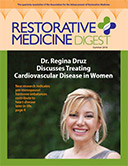Parkinson's disease (PD) is a neurodegenerative condition presenting with both motor and non-motor symptoms. Non-motor symptoms, such as depression, anxiety, reduced sense of smell, and constipation can predate motor symptoms by many years. Other potential prodromal markers of PD include sleep disorders, in particular, rapid eye movement (REM) sleep behavior disorder (RBD), which manifests as thrashing, punching, and vocalizations during motor enactment of dreams.
Risk Factors for Parkinson's Disease
A sizeable percentage of people with PD have inherited genetic mutations that are associated with increased risk. Most instances of PD, however, are sporadic, or without any known genetic or environmental causes, although age is the most significant risk factor.1,2
PD is characterized by degeneration of dopamine-producing neurons in the substantia nigra. Increasing evidence suggests that PD has a multifactorial etiology involving complex interactions between genetic and environmental factors that may as yet be unidentified.3
Mitochondrial Dysfunction
It is likely that disordered cellular mechanisms involving misfolded protein aggregation, oxidative stress, and mitochondrial dysfunction reinforce each other to drive PD pathology in the aging brain.4
Pesticide Exposure
A meta-analysis found that exposure to environmental toxins such as pesticides is significantly associated with PD risk and with alterations in genes involved in PD pathogenesis.5
Gastrointestinal Dysbiosis
Protein aggregation of α-synuclein is a hallmark of PD. Intraneuronal α-synuclein deposits, or Lewy bodies, are known to be distributed in the olfactory bulb and enteric nervous system (ENS). One hypothesis is that the pathological signs and symptoms of PD may in part arise from cell-to-cell transmission of α-synuclein from the ENS to the substantia nigra via the vagus nerve and olfactory bulb. It's worth considering that the ENS and olfactory bulb are gateways from the body to the environment, suggesting that environmental triggers may be involved in PD pathogenesis.6
The gut pathogen, Escherichia coli, has been shown to induce α-synuclein aggregations in the gut and brain.7
People with PD have been found to have a three-fold higher risk of testing seropositive for H. pylori infection compared to healthy controls.8
Studies have found differences in colonic microbiota composition and metabolism between people with PD and healthy controls. This suggests intestinal barrier dysfunction and gut immune dysfunction may play a role in PD pathogenesis or progression.9
Vitamin D3 Deficiency
A large cross-sectional and longitudinal trial within the Harvard Biomarker Study found that at least 17% of people with PD are deficient in vitamin D3. This is almost twice the prevalence of vitamin D3 deficiency found in healthy, age-matched controls. Furthermore, Vitamin D3 deficiency was also associated with more advanced disease severity.10
Iron Accumulation
Alterations in iron metabolism leading to iron accumulation can result in α-synuclein aggregation in the olfactory bulb, vagus nerve, and ENS.11
Therapeutic Considerations
Probiotic Therapy
Bacillus subtilis has been found to protect against α-synuclein accumulation.12
Fecal Microbiota Transplantation (FMT)
A study found that FMT via colonoscopy improved both motor and non-motor symptoms of PD.13
Glutathione
The findings of a systematic review suggest that glutathione may help improve motor function in people with PD.14
Herbal Medicine
Rhodiola rosea may increase dopamine levels.15 Mucuna pruriens contains naturally occurring L-DOPA, but it is unlikely to cross the blood-brain-barrier in sufficient amounts.16
Regulating Autophagy
Regulating autophagy and lysosomal production may be a helpful therapeutic approach for patients with PD. Oleuropein aglycone, which is the main polyphenol compound in olive oil, has been shown to activate autophagy and restore autophagy function that was damaged by oxidative stress. Other natural compounds shown to have positive effects on autophagy and lysosome biogenesis include fisetin, Panax notoginseng, and chlorogenic acid, which is derived from caffeine in tea and coffee.17
References
- https://www.ncbi.nlm.nih.gov/pmc/articles/PMC7280945/
- https://www.sciencedirect.com/science/article/pii/S0969996120300577?via%3Dihub
- https://www.sciencedirect.com/science/article/abs/pii/S0197018618300408?via%3Dihub
- https://pubmed.ncbi.nlm.nih.gov/28352155/
- https://www.sciencedirect.com/science/article/abs/pii/S0753332216322958
- https://www.ncbi.nlm.nih.gov/pmc/articles/PMC6547039/
- https://www.nature.com/articles/srep34477
- https://synapse.koreamed.org/articles/1047930
- https://www.ncbi.nlm.nih.gov/pmc/articles/PMC5408370/
- https://www.ncbi.nlm.nih.gov/pmc/articles/PMC3888173/
- https://www.ncbi.nlm.nih.gov/pmc/articles/PMC8044696/
- https://www.ncbi.nlm.nih.gov/pmc/articles/PMC6963774/
- https://www.ncbi.nlm.nih.gov/pmc/articles/PMC7458210/
- https://www.ncbi.nlm.nih.gov/pmc/articles/PMC7751460/
- https://www.ncbi.nlm.nih.gov/pmc/articles/PMC4117113/
- https://www.ncbi.nlm.nih.gov/pmc/articles/PMC8457986/
- https://www.hindawi.com/journals/omcl/2018/8067592/
